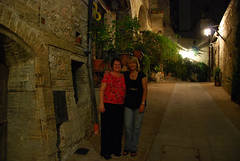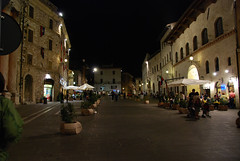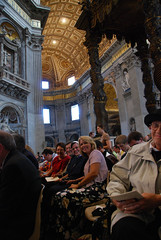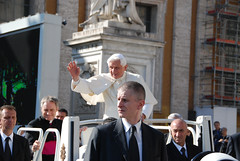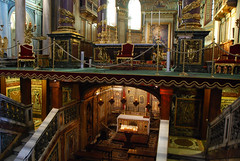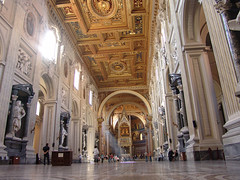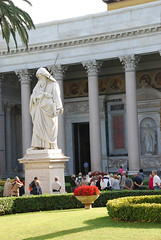A very popular hangout, especially for young lovers who take the time to toss coins into the fountain to make a wish.
Saturday, October 31, 2009
Mary Sculpture
This sculpture was located in the church next to our hotel in Rome. My mother was struck by the realism. Up close you can see Mary's tears as she weeps for her son, Jesus, upon His crucifixtion. The spear symbolizes the pain she suffers.
Assisi Piazza del Comune
Walking up the narrow streets, Shaun, Jenny, and I thought we were lost, and then we came upon the Piazza, alive with people.
Assisi
Assisi is by far the most romantic, charming town I've seen. Only 1000 people reside there year-round. From the streets to the charming buildings, to the shops, to the beautiful St. Francis basilica, everything is amazing. I could have stayed forever, eating gelato and hanging out in the piazza.
St. Peter's Basilica
This is a picture of the stained glass window above St. Peter's chair in the basilica. I found this vision to be typical; just when you think you see everything, your eye begins to wander and then you notice all the other detail. At first, the glass is what struck my eye, but when I start looking at the stuff around it, suddenly I see all the angels and the amazing detail. It's almost too much to take in at once.
Carrano Ordination St. Peter's Basilica
My friend and co-worker, Virginia Carrano, is the one who got me motivated to take this trip. Her son, David, is studying to be a priest in Rome and received his deaconate there, along with 30 or so other seminarians. It was for this occasion that the tour was created. The ceremony was amazing to witness. This is a picture of some of the group members from St. Ann's who went.
Coliseum Exterior
For some reason it surprised me that the coliseum is located in the city. I assumed it was off on some hill or something, but seeing as how it was such a big part of everyday life, the location of it now makes sense.
Coliseum Interior
This is where the emperor would sit as he watched the christians being executed. The cross is dedicated to those christians.
Pope Benedict
Up close and personal. We had front row seats for the papal audience. As he approached Mom, the Pope looked at her and gave her blessing. She's still on a high!
St. Mary Major Manger Relic
Unfortunately, the day we visited St. Mary Major the doors to the manger relic were closed (below, behind the alter). This picture, however, really shows the beautiful detail.
Friday, October 30, 2009
Ced0535: Week Three Reflection
So... I've established my license from Creative Commons; I've created a Flickr account and have finally posted my pictures from my trip to Rome; I have set up my Google Reader with RSS feeds and am checking in as often as I think of it. How can I have done so many things and still feel like I haven't completed anything?
This is the first week in a very long time where I feel slightly out of my league. I get the concept of everything, but I'm used to instant feedback and seeing things finished. I feel like the things we've done in the past two weeks have been a little like fishing; I have baited my hook and now am waiting for things to come my way. The problem is that I feel a little like I've dropped many different lines all over the place, and I'm spending time trying to make my way around to check to see if anything has nibbled yet. Let me make my list, so I can visualize what I've been doing:
1. Twitter
2. Flickr
3. Google Reader
4. Creative Commons
5. Facebook
6. Plurk
Is it any wonder I'm confused? I think part of my confusion is the fact that I feel like there's so much to keep track of now. I have a difficult enough time managing my four email accounts, let alone all this other stuff. In addition, as I stated, I understand the concept of things like RSS feeds, but I still don't quite understand how I can make the most of them. For example, I see Twitter has the RSS feeds, but when I clicked on it, I was asked to enter an admin username and password. That confused me, so I exited out. I love the concept of having everything come to me instead of going to all these various locations. So clearly I have more studying to do.
In terms of my students and what I can use this week in my classroom, I have more thinking to do. I like the idea of students uploading their photos to photo sharing sites, such as Flickr, but again I know I'm going to run into trouble with their age. Even when I had them establish their Ning accounts, the minimum age was 13. I have to admit that I had them agree to the age so that we could work the Ning. I am feeling the same way about Flickr, Twitter and others. I'm not sure what the age requirement is or if there is one, but even if there isn't, the site asks for name, etc. At what point can my students honestly answer the questions that they are asked when registering to all these different places? Currently, I don't envision incorporating sites like Twitter into my curriculum. I don't think any of them "tweet" as yet, and I'm not sure if they would really get into it. They enjoy the more personal feedback they get with emailing or chatting. I think sites such as Twitter might actually bore them after a time. I know, on the other hand, they would love it if I let them open Facebook accounts, but then I'd feel obligated to constantly monitor their usage, and that challenge is way too big for me. I do, however, like the idea of teaching them the RSS feeds. I agree with some of the articles we read that with so much info on the Internet, we have to teach students how to find the info they need without overloading them. RSS feeds would really help them keep track of reliable sources and information. The challenge would be walking through Google Reader with them and finding sites they'd like to watch. I think I would begin by having them locate info of their own interests and adding them. Then we could move into sources for classes. Another must would be teaching them how to organize their sites.
This is the first week in a very long time where I feel slightly out of my league. I get the concept of everything, but I'm used to instant feedback and seeing things finished. I feel like the things we've done in the past two weeks have been a little like fishing; I have baited my hook and now am waiting for things to come my way. The problem is that I feel a little like I've dropped many different lines all over the place, and I'm spending time trying to make my way around to check to see if anything has nibbled yet. Let me make my list, so I can visualize what I've been doing:
1. Twitter
2. Flickr
3. Google Reader
4. Creative Commons
5. Facebook
6. Plurk
Is it any wonder I'm confused? I think part of my confusion is the fact that I feel like there's so much to keep track of now. I have a difficult enough time managing my four email accounts, let alone all this other stuff. In addition, as I stated, I understand the concept of things like RSS feeds, but I still don't quite understand how I can make the most of them. For example, I see Twitter has the RSS feeds, but when I clicked on it, I was asked to enter an admin username and password. That confused me, so I exited out. I love the concept of having everything come to me instead of going to all these various locations. So clearly I have more studying to do.
In terms of my students and what I can use this week in my classroom, I have more thinking to do. I like the idea of students uploading their photos to photo sharing sites, such as Flickr, but again I know I'm going to run into trouble with their age. Even when I had them establish their Ning accounts, the minimum age was 13. I have to admit that I had them agree to the age so that we could work the Ning. I am feeling the same way about Flickr, Twitter and others. I'm not sure what the age requirement is or if there is one, but even if there isn't, the site asks for name, etc. At what point can my students honestly answer the questions that they are asked when registering to all these different places? Currently, I don't envision incorporating sites like Twitter into my curriculum. I don't think any of them "tweet" as yet, and I'm not sure if they would really get into it. They enjoy the more personal feedback they get with emailing or chatting. I think sites such as Twitter might actually bore them after a time. I know, on the other hand, they would love it if I let them open Facebook accounts, but then I'd feel obligated to constantly monitor their usage, and that challenge is way too big for me. I do, however, like the idea of teaching them the RSS feeds. I agree with some of the articles we read that with so much info on the Internet, we have to teach students how to find the info they need without overloading them. RSS feeds would really help them keep track of reliable sources and information. The challenge would be walking through Google Reader with them and finding sites they'd like to watch. I think I would begin by having them locate info of their own interests and adding them. Then we could move into sources for classes. Another must would be teaching them how to organize their sites.
Friday, October 23, 2009
CEd0535: Session Two - Wikis at Work
It would be amusing to go back through my blogs and count the number of times I made comments, like "I never realized..." Seems I'm repeating myself constantly. This week is no different, and once again, I'm on a totally new path in my curriculum. I'm quickly discovering that when it comes to the stuff we learn, I'm not content to wait til next year to include them. Instead, I stop everything I'm doing now and shift totally.
Like many others in class, I'm sure, I had understood wikis and how they are used, but I never considered actually incorporating a wiki for my school where students could go and add information. I have created a Ning, but really I'm only using it as a blogging tool, not a place where student research could be posted and where other students could go and add to or make corrections. I guess I just never thought about the potentials of a wiki. Now that I'm aware, my mind is exploring all sorts of wikis we could create. For one, I could create a wiki that focuses on saints. One of my big complaints with our curriculum is that each grade level explores saints and often repeats the same activities over and over again. Too redundant. If I created a wiki, however, the students could do their initial research in Grade 3 or 4 and then when they have to repeat their saint research, they could explore further and simply modify the wiki. Or perhaps they will select a new saint and then check their saint on our wiki to see if the information is accurate. In addition, they might find more interesting pictures or video on which to expand. This project could really be cool. There are lots of websites out there that focus on saints, but most of them are geared toward an older age level. There's not much there that is directed towards kids. Our wiki could fill that niche.
I'd like to start this immediately. As stated above, I don't like to delay long when I have an inspiration. The difficulty this time, however, is that I think I do need to first develop a policy for publishing on the Internet. If we want this wiki to be useful, we're going to have to go public, and doing so without getting parental permission first may send some of my parents into orbit. I will also need to take necessary measures to ensure that my students don't disclose personal information. This means not only monitoring them but also making sure they really, really understand why they should not do so. I also then need to get talking with my teachers to see how we could make all of this gel. Ideally, I'd like to create the wiki and monitor it and then have the actual religion teachers in charge of its use. Since Wikipedia is about the only wiki my teachers are aware of, I'll need to spend time inservicing them.
Like many others in class, I'm sure, I had understood wikis and how they are used, but I never considered actually incorporating a wiki for my school where students could go and add information. I have created a Ning, but really I'm only using it as a blogging tool, not a place where student research could be posted and where other students could go and add to or make corrections. I guess I just never thought about the potentials of a wiki. Now that I'm aware, my mind is exploring all sorts of wikis we could create. For one, I could create a wiki that focuses on saints. One of my big complaints with our curriculum is that each grade level explores saints and often repeats the same activities over and over again. Too redundant. If I created a wiki, however, the students could do their initial research in Grade 3 or 4 and then when they have to repeat their saint research, they could explore further and simply modify the wiki. Or perhaps they will select a new saint and then check their saint on our wiki to see if the information is accurate. In addition, they might find more interesting pictures or video on which to expand. This project could really be cool. There are lots of websites out there that focus on saints, but most of them are geared toward an older age level. There's not much there that is directed towards kids. Our wiki could fill that niche.
I'd like to start this immediately. As stated above, I don't like to delay long when I have an inspiration. The difficulty this time, however, is that I think I do need to first develop a policy for publishing on the Internet. If we want this wiki to be useful, we're going to have to go public, and doing so without getting parental permission first may send some of my parents into orbit. I will also need to take necessary measures to ensure that my students don't disclose personal information. This means not only monitoring them but also making sure they really, really understand why they should not do so. I also then need to get talking with my teachers to see how we could make all of this gel. Ideally, I'd like to create the wiki and monitor it and then have the actual religion teachers in charge of its use. Since Wikipedia is about the only wiki my teachers are aware of, I'll need to spend time inservicing them.
Wednesday, October 14, 2009
Ced0535: Week One Reflection
Just when I thought I had thought enough about blogs and wikis, I quickly discover I know very little. Obviously because of the blogging we do for this program, I thought I had a pretty good handle on blogs and how to implement them for my school. I never realized, however, the can of worms I would open after reading the first three chapters of our textbook. Now my mind is reeling from all the different ways I can use blogs at my school. I really only considered the educational application and in fact jumped right in and created a Ning for my 5th and 6th graders which is going very well. The students are now excited about writing and exploring the blog. What I am finding most helpful this week is how to sift through the details. Clearly it's not enough to just create a blog space; now I need to consider the best ways to use it and how to create guidelines for its use. Prior to this week, I was very hesitant to let students roam freely around our Ning. Almost immediately upon its creation, I had numerous students wanting to post their own pictures and personalize their page. My first response was "no" of course, fearing that they might post things that reveal too much personal information or might not be educational. But after reading the first three chapters, especially chapter 3, I see that it is important for students to take ownership of this space. Also, I have to remember, as the creator of our Ning, that I have ultimate control and can eliminate anything that crosses the line. I think also, as the safety section of the textbook reveals, that I need to get a policy together that assures parents and administration that our social network will be monitored no differently than their email and Internet use. I think the biggest challenge is that the majority of my parents and principal have no idea what a Ning or wiki is all about and so automatically assume they're recreational and danger zones. This is what will take the most time to overcome, but perhaps if I invite my parents and principal to join the Ning, the fears will be alleviated some. It also might be a great way to open the communication between all of us. I would love having parents comment on the same things that their kids are. And if I post regularly, regarding the things going on in class, then it would be another way to keep parents informed and updated. Finally, I would also like to establish a Ning for our faculty and staff as a way to share ideas and stay informed. Right now, there's way too much paper floating around with redundant messages. I would like very much to go paperless, and I would have a much easier time keeping track of things, as opposed to all the papers I now have to sift through. So what I once thought was a purely educational tool is now expanding in all sorts of directions.
Subscribe to:
Posts (Atom)


